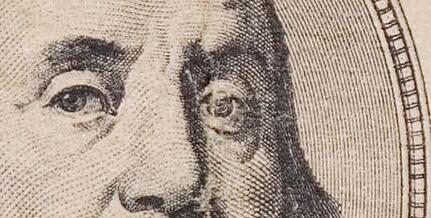We mentioned previously the intaglio printing process that creates fine lines around the portraits on genuine dollars. Now we get to see some details on the lines. Below is a magnification of Benjamin Franklin's engraved portrait on a $100 bill.

The oval shaped area containing the portrait and the fine-line patterns behind the portrait are made using intaglio printing, enabling very high resolution images and also “ridges”, essentially ink-filled grooves produced by very heavy (something on the order of 20 tons) pressure. The individual “ridges” in the paper can actually be felt by running a fingernail across the lines.
Your typical counterfeit bill will not fully duplicate the level of detail: it would likely have smudged or scratched fine lines and a smooth to the touch surface; overall, looking somewhat like in the picture below.

High-end modern copiers are getting better at reproducing the visual effect of fine semi-circular lines you see running around the face, but without intaglio printing presses cannot duplicate the raised-ink feel of genuine dollars. A smooth surface or noticeable breaks in the fine lines within the portrait are sure signs of a forgery.


